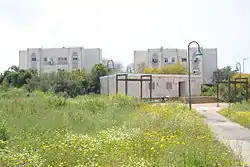Harish, Israel
Harish (Hebrew: חָרִישׁ, cha-reesh, lit. "ploughed furrow") is a town and a local council in the Haifa District of Israel. Its jurisdiction is an area of 9,736 dunams.[2] It is currently being expanded into a city projected to eventually have a population of 100,000. In 2019 it had a population of 13,232.[1]
Harish
| |
|---|---|
| Hebrew transcription(s) | |
| • ISO 259 | Ḥariš |
 | |
 Harish  Harish | |
| Coordinates: 32°27′33″N 35°2′34″E | |
| Country | |
| District | |
| Founded | 1982 |
| Area | |
| • Total | 9,736 dunams (9.736 km2 or 3.759 sq mi) |
| Population (2019)[1] | |
| • Total | 13,232 |
| • Density | 1,400/km2 (3,500/sq mi) |
| Name meaning | Ploughed furrow |
History


Harish was founded as a Nahal settlement in 1982 and converted into a kibbutz in 1985. The kibbutz disbanded in 1993.
Following a government decision, a new neighborhood of 300 housing units was built on the site and marketed to career army officers, although few moved there.[3] Harish merged with the neighboring town of Katzir, forming Katzir-Harish.[4] They separated again in 2012, with Harish remaining a town, and Katzir reverting to the jurisdiction of Menashe Regional Council.
In the 1990s, the low cost of housing attracted young couples, mostly secular, but in 2003, a group of Garin Torani families moved to the town. In addition, an Arab Bedouin clan from Ramla moved there in order to end a bloody feud with another clan.[5]
In 2007, Israeli Housing Minister Ariel Atias came up with a plan to develop Harish into a city with a population of 100,000. Fearing it would become a Haredi stronghold,[6] the secular residents led by Hemi Bar-Or petitioned the Israeli Supreme Court. Housing tenders were opened to the general public, attracting Israelis looking for affordable housing and bicycle enthusiasts who eyed the nearby forests as a weekend cycling destination.[3] In 2012, a secular buyers' group bid on lots zoned for 400 housing units.[7]
A master plan for Harish designed by Mansfeld-Kehat Architects calls for the expansion of Harish to Highway 65 in the north, and Baqa al-Gharbiyye in the south.[8] Construction of new neighborhoods began in 2013.[9] By August 2015, construction was well underway, with many buildings nearing completion.[3]
In January 2016, the Israeli cabinet approved a 1 billion NIS plan to turn Harish into a city of 50,000 in three years, with the eventual goal of 100,000. Harish will be expanded to the northeast, with residential areas, a business zone, a hotel, 600 dunams of public parks and gardens, and a special site consolidating all emergency services.[10]
Harish is being built as a smart city, with full WiFi coverage and its own fiber optic cables, LED streetlights with sensors, camera-equipped lampposts, and smart trash cans that will signal trucks through the Internet when they need to be emptied.[3] A 60 meter wide main boulevard will be built with an island in the middle lined with bicycle paths, benches, and small cafes. It has also been suggested that a light rail line may be built in the future.[3]
Bronze Age Megalopolis
Archaeologists discovered the ruins of a 5,000 year-old city, the largest Early Bronze Age settlement with an area of 160 acres in Ein Esur archaeological site in 2019. According to the archaeologist Dr. Yitzhak Paz from the Israel Antiquities Authority, “this site is more than two or three times larger than the others [in this area] during this period.” Millions of pottery shards and basalt stone vessels, several figurines of people and animals, tools imported from Egypt, flint tools were also found from the site.[11]
In addition to this, just ahead of this archaeological site, the remains of a 7,000-year-old Chalcolithic settlement also was revealed by IAA archaeologists below the 5,000-year-old ruins.[12]
“This is a huge city – a megalopolis in relation to the Early Bronze Age, where thousands of inhabitants, who made their living from agriculture, lived and traded with different regions and even with different cultures and kingdoms in the area. This is the Early Bronze Age New York of our region; a cosmopolitan and planned city,” said excavation directors.[13]
References
- "Population in the Localities 2019" (XLS). Israel Central Bureau of Statistics. Retrieved 16 August 2020.
- "Local Authorities in Israel 2005, Publication #1295 - Municipality Profiles - Katzir-Harish" (PDF) (in Hebrew). Israel Central Bureau of Statistics. Retrieved 2008-08-01.
- Weinglass, Simona (August 25, 2015). "New town Harish harbors hopes of being more than another Pleasantville". The Times of Israel. Retrieved April 23, 2019.
- HaReuveni, Immanuel (1999). Lexicon of the Land of Israel (in Hebrew). Miskal - Yedioth Ahronoth Books and Chemed Books. p. 840. ISBN 965-448-413-7.
- Simon, Daniel Ben (July 12, 2013). "Israeli Settlement Harish a Dismal Failure". Al-Monitor. Retrieved October 7, 2019.
- Rinat, Zafrir (July 18, 2011). "A Haredi City on the Horizon". Haaretz. Retrieved April 23, 2019.
- Paz-Frankel, Einat (September 10, 2012). "Secular Israelis make move on new city Harish". Globes. Retrieved April 23, 2019.
- "Harish Master Plan, 2007". Mansfer-Kehat Architects. Retrieved 2016-09-27.
- https://www.harish.co.il/about-harish
- http://jpupdates.com/2015/12/20/israels-cabinet-approves-one-billion-shekalim-for-new-city-of-harish/
- "Ancient 'New York': 5,000-year-old city discovered in Israel". BBC News. 2019-10-07. Retrieved 2020-04-26.
- Liebermann, Oren (2019-10-07). "Archaeologists find 5,000-year-old 'New York' in Israel". CNN Travel. Retrieved 2020-04-26.
- Amanda Borschel-Dan. "'Israel's ancient NYC': 5,000-year-old Canaanite megalopolis may rewrite history". www.timesofisrael.com. Retrieved 2020-04-26.